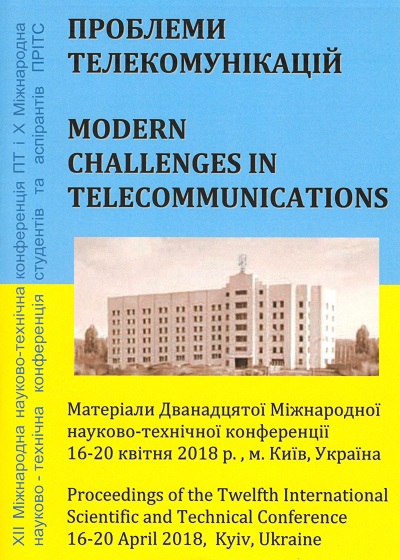РЕАЛІЗАЦІЯ МІМО-СИСТЕМИ ДЛЯ ТСВА ШЛЯХОМ ФОРМУВАННЯ ВІРТУАЛЬНОЇ АНТЕННОЇ РЕШІТКИ
Анотація
Implementation of the MIMO-system for
HAPS by forming a virtual antenna array
A mathematical model of the virtual antenna system MIMO was developed by combining a constellation of interconnected stations on the basis of a high-altitude aeroplatform lying in the field of view of the terrestrial terminal. In this case, in the case of shaded Raysov fading, a function of probability density (PDF), cumulative distribution function (CDF), probability of interruption of communication and ergodic bandwidth of the system for the signal / noise ratio on the receiver of the user terminal are developed.
Посилання
Ільченко М.Ю., Кравчук С.О. Телекомунікаційні системи. – К.: Наукова думка, 2017.
Кравчук С.А. Преимущества беспроводной архитектуры распределенной антенной системы над традиционной сотовой структурой // Зб. тез 3-ї міжнародної наук.-техн. конф. "Проблеми телекомунікацій", 21–24 квітня 2009 р., м. Київ, Україна. – К.: НТУУ "КПІ", 2009. – С. 48.
Kravchuk S.O. The mathematical model of the outage probability in MIMO-system with Rician fading and limited signal-to-noise relation // Modern information technologies in the sphere of security and defence. – 2015. - Nr 1 (22). – Р. 63-67.
Кравчук С.О., Міночкін Д.А. Застосування багатоантенної технології МІМО в системах мобільного зв’язку специфікацій Long Term Evolution // Зб. наук. праць ВІТІ НТУУ «КПІ». – 2011. – № 1. – С. 85-99.
##submission.downloads##
Як цитувати
Номер
Розділ
Ліцензія
Авторське право (c) 2018 Сергій Олександрович Кравчук, Ірина Михайлівна Кравчук

Ця робота ліцензується відповідно до Creative Commons Attribution 4.0 International License.
Authors who submit to this conference agree to the following terms:a) Authors retain copyright over their work, while allowing the conference to place this unpublished work under a Creative Commons Attribution License, which allows others to freely access, use, and share the work, with an acknowledgement of the work's authorship and its initial presentation at this conference.
b) Authors are able to waive the terms of the CC license and enter into separate, additional contractual arrangements for the non-exclusive distribution and subsequent publication of this work (e.g., publish a revised version in a journal, post it to an institutional repository or publish it in a book), with an acknowledgement of its initial presentation at this conference.
c) In addition, authors are encouraged to post and share their work online (e.g., in institutional repositories or on their website) at any point before and after the conference.

